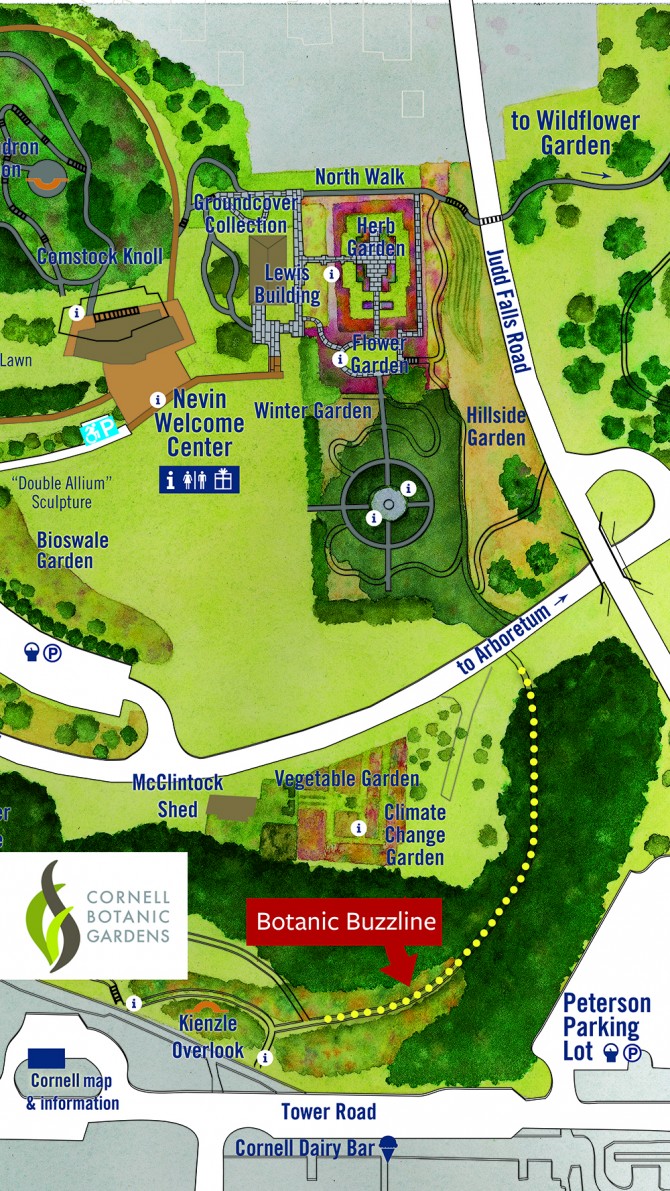
From left, Diego Burga ’21, Samantha Spicka ’21 and Lev Krasnovsky ’21 install signage along the new Botanic Buzzline garden path in Cornell Botanic Gardens. The path is scheduled to open Sept. 14.
New ‘Botanic Buzzline’ trail connects people, pollinators
By Shannon Dortch
A 380-foot-long flowering pathway – a project initiated by students to help pollinating insects navigate fragmented green spaces – opens Sept. 14 at Cornell Botanic Gardens.
The Botanic Buzzline provides pollinators – especially those that can travel only very short distances between stops for nectar – with a continuous patch of uninterrupted flowers. It connects the Tower Road area near the Cornell Dairy Bar to the abundant plants below it in Cornell Botanic Gardens’ collections. Four biology undergraduates in the College of Arts and Sciences collaborated with the Botanic Gardens over 18 months to plan, fund and implement the garden.
Pollinator-friendly pathways like the Botanic Buzzline help preserve pollinator biodiversity. Native pollinators, in particular, are often best suited to pollinate local plants so maintaining their numbers is especially important, said project lead Lev Krasnovsky ’21.
“Most people have probably heard of the fight to ‘save the bees.’ However, relatively few undertakings exist to provide similar support for hoverflies, moths or other lesser-known pollinators,” Krasnovsky said. “Unlike the honeybee, many native pollinators can’t travel more than a few hundred feet. If there are no flowers within a certain radius, these pollinators can easily get stuck on a green island.”
The team behind the Botanic Buzzline is four third-year students – Krasnovsky, Diego Burga ’21, Samantha Spicka ’21 and Lisa Yu ’21 – who met through the Biology Service Leaders Program. Inspired by Seattle’s Pollinator Pathway and similar installations, the team wanted to build a flowering pathway to help native pollinators navigating across fragmented vegetative spaces on the Cornell campus.
With the help of Cornell Botanic Gardens and the Office of Alumni Affairs and Development, the group surpassed its crowdfunding goal by raising more than $11,000 to fund the path’s design, planting and first three years of maintenance.
“We could not have imagined how well this project would be received.” Krasnovsky said, noting that more than 100 people donated or volunteered their time.
Volunteers helped prepare the soil for planting in November of 2018, and with perennial planting in May. The methods used to prepare the soil included sheet mulching, which smothers weeds with a layer of cardboard and soil, eliminating the need for pesticides.
As the plants matured over the growing season, Botanic Buzzline team members collaborated with the Botanic Gardens to design educational signs explaining the garden to visitors. These include a honeycomb-inspired, six-sided sign that visitors can spin to read information about the Botanic Buzzline, as well as a brochure and five small “fun fact” signs scattered among the plants.
“These materials are designed to increase awareness of the critical need to protect pollinator species in decline and inspire people to create pollinator-friendly habitats at home,” said Sarah Fiorello, interpretation coordinator for Cornell Botanic Gardens.
With the development of the Botanic Buzzline, the student team addressed a broad environmental problem with a local solution.
“The Buzzline is such a simple idea, but its effects are profound – for insects, plants and visitors,” Krasnovsky said. “It really is possible to make positive changes in our local communities.”
The Botanic Buzzline grand opening will be held from noon to 2 p.m. Sept. 14, outside the Nevin Welcome Center, immediately following the regularly scheduled garden tour at 11 a.m. The event will include refreshments, information about helping native pollinators, and free seed packets while supplies last.
Shannon Dortch is associate director of communications and marketing at Cornell Botanic Gardens.
Media Contact
Get Cornell news delivered right to your inbox.
Subscribe

